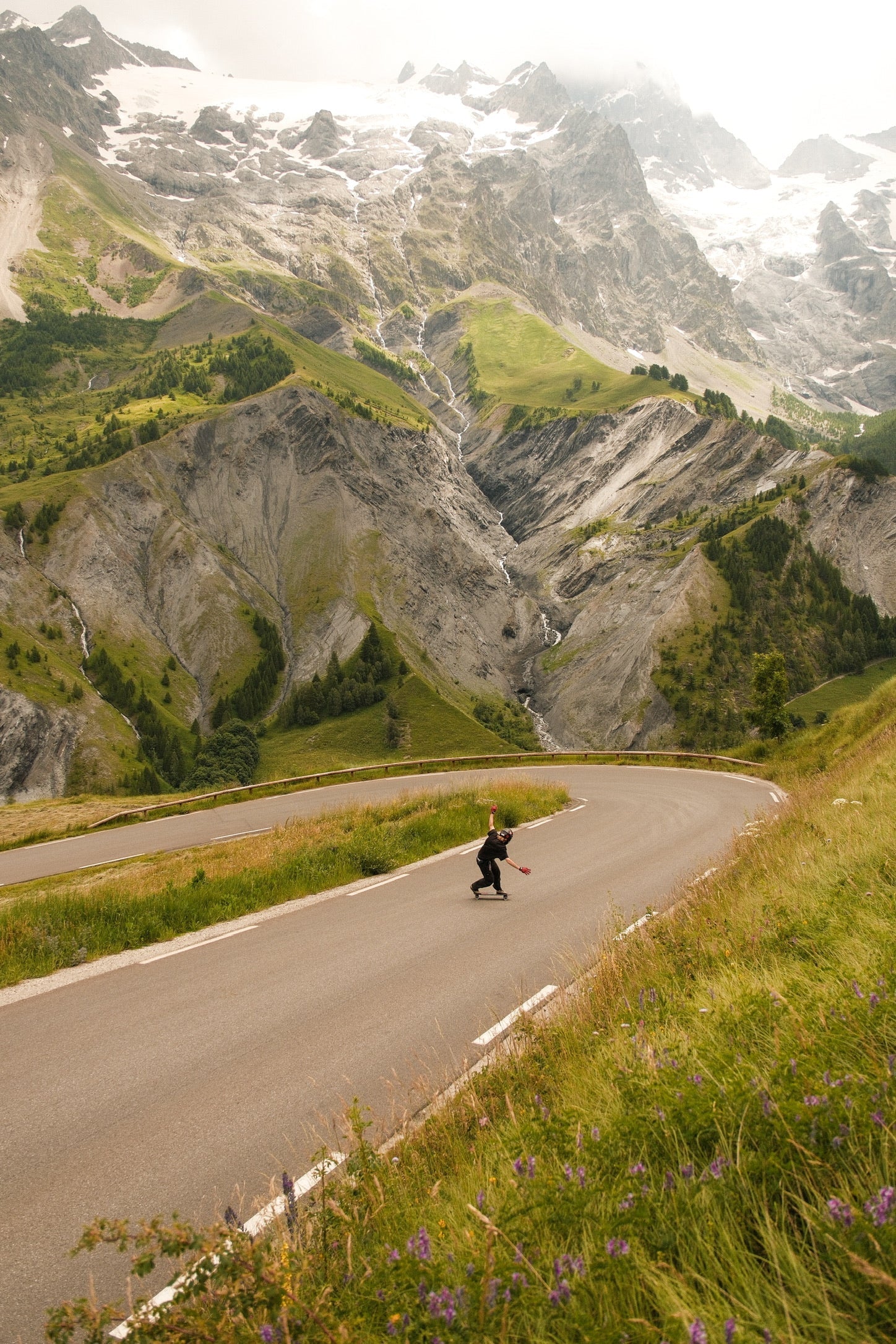This guide outlines universal safety rules for downhill longboarding on open roads, specifically in Europe. The aim is to ensure that all riders are on the same page to minimise accidents caused by miscommunication or lack of information. By following these guidelines, riders can better understand how to prepare and share the road safely.
1. Assessing the Safety of a Spot
This part should help you evaluate the safety factor of a spot. It isn't only speed that matters, but many more parameters that will make the spot effectively safer or sketchier. Before skating any spot, remember to always drive up the hill to check for surprises like wet patches, rocks, or sand - even if you're familiar with the road. The key factors to evaluate are:
-
Traffic: Check the road’s traffic levels based on the time of day. It’s generally safest to skate early (5–7 AM) or late (7–9 PM).
-
Road width: A middle lane offers more room to manoeuvrer. If there’s no middle lane, judge whether it's safe or not to cross paths with cars, especially around corners.
-
Pavement quality: Look out for any cracks, gravel, or melted asphalt, as these could affect your line.
-
Guardrails and hazards: Guardrails, cliffs, or bridges create "no-crash" zones.
-
Steepness: Compare it to roads you've already ridden, if you are intimidated, it is always good to start with a corner session to warm up.
-
Legality: Know the local laws, as skating in some areas might be forbidden. Skating forbidden roads adds pressure to the whole group and thus require more experienced riders.
-
Emergency services: Be cautious in remote areas where emergency response may be delayed.
2. Establishing a Safety Strategy
Depending on the difficulty of the spot related to the experience and skill level of your group you can adopt one of the following safety strategies:
-
Sweep vehicle only: Generally not recommended. To be done solely on wide roads with great visibility, smooth pavement and moderate speed. The car stay behind the riders and make sure everyone got down safely. Riders should stay on their lane and always be prepared to stop if something unusual occurs (large truck, tractor, off-road motorbikes...)
-
Opening car: Recommended for most spots. One car goes in front of the riders and spot for eventual dangers down the roads. Riders should be about 15 seconds behind the opening car and receive information through a walkie talkie. They all should keep pace with or be faster than the traffic. If additional cars are needed to drive everyone back up, they should all stay behind the last rider of the pack. Transmission from the opening car ends when the sweep vehicle are parked, meaning all riders are down. Remember, do not distract the spotter while riders are still on the road.
-
Temporarily closed road: Only for ultra low-traffic roads. Park the car down the road in such a way to prevent any vehicles from going up. Keep constant walkie talkie to confirm that the road is free. Only apply this strategy on short spots with no junctions. Be extra cautious about dirt paths or parked cars that may re-enter the road unexpectedly. Check for any sign of off-road activities as those vehicles can get on the road despite it being virtually closed.
-
Nothing: Remember that skating "free solo" is actually safer than skating depending on a sketchy safety strategy.
Safety is a teamwork. To be effective it requires everyone to be well informed, well equipped* and serious about it. We strongly recommend to use the solution N°2 using the opening car on most spots and train your crew to become masters of it.
*remember to charge your talkies. We recommend to replace the reusable internal battery by dispensable batteries to increase reliability. And make sure to have some fresh ones with you.
3. Driving the opening car
Driving the opening car is challenging as it requires solid multi-tasking. It is something that needs practice to be well done and it is very important to support new riders while learning this skill.
-
Drive the car while keeping pace with the riders.
-
Spot for relevant dangers.
-
Evaluate and report dangers by operating the walkie-talkie.
1. Drive
The opening car should maintain a constant distance to the riders by being between 15 to 30 seconds ahead of the pack. If riders are too close to the opening car, they might not have time to react to talkies announcements. If riders are too far from the opening car, the spotting can become obsolete and "ghost cars" can appear, because of junctions or parked cars.
Because of that it is safer to operate with a group of riders that have the same rhythm. If the gap in-between riders grows too much during the run, consider either adding a pause mid-run to regroup or splitting in homogeneous speed groups to keep denser packs.
It is also the driver role to manage that distance. To do so, the driver can use long straights before hairpins to slow down and allow the riders to catch up before continuing. If the opening car is slowed down by a slow vehicle, announce it like any other hazard to notice the riders to slow down too. If the vehicle is dangerously slow (ex: tractor), consider stopping in a safe zone to regroup with the riders and give it more room.
2. Spot
While spotting, the life of your friends rely on the informations you're giving. It is a true responsibility and it is normal (and good) to feel some pressure. Even though announcing oncoming traffic is key, the spotter's role goes beyond that: it needs to identify and evaluate any potential danger. Look for parked cars, any pedestrian nearby that might get in the car and drive it in a near future? On each junctions, is there cars coming that could get on the roads during the next 10 secs? Look also for bicycles and announce them properly as they often tend to wiggle a bit up the hills. Be aware of motorcycle groups or sport cars enthusiast as they often cut corners.
Overall, report everything that could eventually be a danger. As long the instructions are clear the riders are going to adapt their rate to those information.
3. Communicate
The communication from the opening car to the riders is secured by walkie-talkies with an always-on logic. And no, phones aren't reliable enough to replace talkies, especially in mountainous regions.
While the road is clear, the operator should continuously transmit a "road clear" signal to the riders (ex: by saying salves of "okay, okay, okay" every 5 seconds). Always-on logic means that no signal = danger. Only hearing "okay okay okay" means that the road is clear.
When spotting a danger, use clear and repetitive language. Riders should be able to know what kind of danger it is and have a distinctive element to be able to correlate the danger to the talkie announcement. For example, if the danger is "a car", the distinctive element can be its colour. And so the announcement would be "a blue car is coming up, a blue car is coming up ... I repeat a blue car is coming up, a blue car is coming up". Riders can then identify the blue car and know the road is clear after passing it.
Small tips: Change your tone when announcing a danger, but maintain constant flat tone while the road is clear. Hold walkie talkie button, inhale, THEN talk. The transmission can take as much as a whole second to start after you press the button! Do not hesitate to repeat 3 to 4 times each danger before switching back to the "okay okay okay".
If you encounter any issue when driving the opening car (ex: mechanical failure, flat battery in talkie...), stop on the side of the road in a safe spot and cease transmission. Riders should get down the hill safely - skating super chill in fully open road and meet with you.
By following these guidelines, you can ensure a safer and more organised experience when downhill longboarding on open roads. Remember, the safety of everyone on the road, including other drivers, depends on your ability to communicate clearly, spot effectively, and skate responsibly. Have fun!



Share:
The first step of La Paulade: Crafting the PolYmers
1 comment
Too much reliance on walkies and spotters can be a bad thing imo. It makes you soft and vulnerable to variables. Just learn to skate in your lane, react quickly and stay calm.
I agree it’s great for certain roads but to me, trying to control your environment is the wrong approach compared to learning to adapt to your environment.
Also I would hate listening to someone say “clear” in my ear nonstop for potentially 10+min lol totally kills the experience